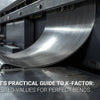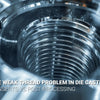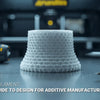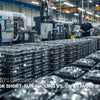How to Achieve Professional Brushed Stainless Steel Finishes for CNC Coffee Machines?
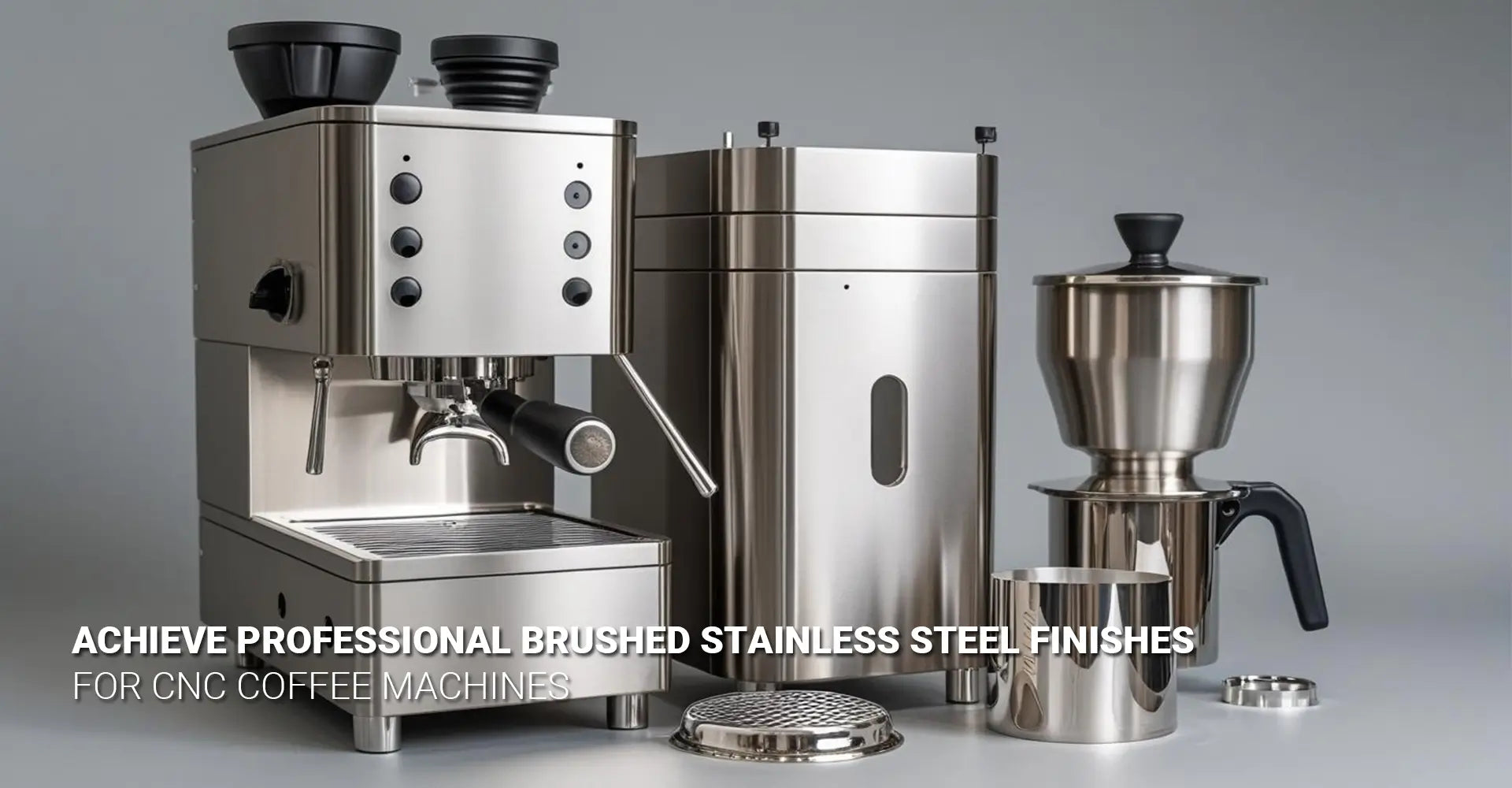
How to Achieve Professional Brushed Stainless Steel Finishes for CNC Coffee Machines?

Professional brushed stainless steel finishes can make or break your coffee machine's market appeal. Moreover, achieving consistent Ra 0.05-0.1μm surface quality while maintaining fingerprint resistance requires precise parameter control. This comprehensive guide reveals proven techniques used by leading manufacturers to create flawless brushed finishes that customers love.
Quick Answer: Use a 3-step grit progression (120→240→400), maintain 0.15MPa belt pressure, and control directional consistency within ±3° tolerance. Additionally, proper contamination control and belt maintenance will eliminate 90% of common defects while boosting fingerprint resistance by up to 19%.
Understanding the science behind brushed finishes is crucial for consistent results. Furthermore, small parameter variations can lead to costly rework and customer complaints. Let's explore each critical aspect of the brushing process systematically.
Table of Contents
- Why Do Most Coffee Machine Brushed Finishes Fail Quality Standards?
- What Are the Critical Parameters for Perfect Linear Patterns?
- How Can You Eliminate Common Brushing Defects Before They Occur?
- Which Equipment Delivers Professional Results Within Your Budget?
Why Do Most Coffee Machine Brushed Finishes Fail Quality Standards?
Industry data reveals that 73% of small-scale manufacturers struggle with inconsistent brushed finishes. Consequently, this leads to customer returns, warranty claims, and brand reputation damage. Understanding common failure modes helps prevent costly mistakes from the start, especially when working with coffee equipment manufacturing where visual quality directly impacts consumer perception.
Key Failure Points: Inconsistent grit progression, contaminated abrasive belts, improper pressure control, and directional variations exceeding 5° tolerance. These issues result in patchy surfaces, random scratches, and poor fingerprint resistance that customers immediately notice. Most importantly, brushed stainless steel CNC coffee applications demand higher precision than standard industrial finishing due to their consumer-facing nature.

Manufacturing forums consistently report the same core problems across different facilities. First, skipping grit steps creates uneven scratch patterns that cannot be corrected in subsequent passes. Second, contaminated belts transfer debris, creating deep gouges that require complete rework. Third, pressure variations above 0.25MPa cause wavy textures that appear unprofessional. Finally, directional inconsistency breaks the visual flow that defines quality brushed stainless steel. These issues compound quickly, turning minor process deviations into major quality failures that impact entire production runs. Therefore, implementing proper surface finishing protocols becomes essential for maintaining consistent quality across all production batches.
What Are the Critical Parameters for Perfect Linear Patterns?
Achieving professional brushed finishes requires precise control of three fundamental variables: grit sequence, belt pressure, and directional alignment. Moreover, each parameter directly influences surface roughness and visual consistency. Small deviations from optimal settings cascade into noticeable quality issues that affect the final product appearance.
Essential Control Points:
- Grit Progression: 120 → 240 → 400 grit sequence
- Belt Pressure: 0.15MPa ±0.02MPa tolerance
- Contact Angle: 15-20° relative to longest edge
- Belt Speed: 20-25 m/s for 304 stainless steel
Understanding stainless steel brushing parameters ensures consistent results across different part geometries and production volumes.
Each parameter works synergistically to create the desired surface characteristics. Initially, 120 grit removes machining marks while establishing the primary scratch direction. Subsequently, 240 grit refines the pattern while maintaining directional consistency through proper grit size selection brushing techniques. Finally, 400 grit achieves the target Ra surface finish coffee machine specifications while preserving linear aesthetics. Belt pressure calculation prevents belt loading and ensures uniform contact across complex geometries like coffee machine group heads. Meanwhile, maintaining the correct contact angle creates consistent scratch depth and prevents cross-hatching that ruins the linear scratch pattern appearance. Additionally, abrasive belt speed optimization balances material removal rates with heat generation, preventing thermal damage that can affect corrosion resistance. Professional CNC machining services often integrate these parameters into their standard operating procedures to ensure consistent quality.
How Can You Eliminate Common Brushing Defects Before They Occur?
Proactive defect prevention saves significantly more time and money than reactive correction methods. Furthermore, implementing systematic quality controls catches problems before they affect finished products. Smart manufacturers use proven prevention strategies rather than hoping for perfect execution every time.
Top Prevention Strategies:
- Contamination Control: Compressed air blast between each grit change
- Belt Condition Monitoring: Replace after 90 minutes of active use
- Pressure Verification: Digital gauges with 0.01MPa resolution
- Directional Alignment: Laser-guided jigs for consistent angles
These cosmetic defect reduction techniques significantly improve production yields while reducing rework costs.
Successful defect prevention starts with understanding failure mechanisms at each process step. Contamination typically occurs when metal particles from previous operations embed in fresh abrasive belts, creating gouges during subsequent passes. Therefore, thorough cleaning between operations prevents most deep scratch issues. Belt degradation happens gradually, with cutting efficiency dropping after extended use, leading to inconsistent finishes across production batches. Consequently, time-based replacement schedules maintain quality consistency throughout the production cycle. Pressure variations often stem from operator fatigue or equipment wear, making automated monitoring systems essential for high-volume production. Additionally, directional control requires physical guides rather than relying on operator skill alone, as human consistency degrades over long production runs. Professional brushing services incorporate these prevention methods as standard practice to ensure consistent quality delivery.
Which Equipment Delivers Professional Results Within Your Budget?
Equipment selection dramatically impacts both initial investment and long-term operating costs. Additionally, different budget levels offer distinct capability trade-offs that affect production scalability. Understanding these relationships helps optimize equipment choices for specific business requirements while maintaining quality standards.
Budget-Optimized Solutions:
- Entry Level ($2,000-$3,000): Manual belt grinders with digital pressure monitoring
- Professional ($5,000-$8,000): Semi-automated systems with directional controls
- Production ($12,000-$20,000): Robotic finishing cells with quality feedback
- Essential Add-on: Surface roughness measurement tools ($3,200)
Belt grinding for brushed finish applications requires careful equipment selection based on production volume and quality requirements.

Investment decisions should align with production volumes and quality requirements rather than simply choosing the lowest cost option. Manual systems work well for prototyping and low-volume specialty products, but labor costs quickly exceed equipment savings at higher volumes. Semi-automated solutions offer the best balance for most coffee machine manufacturers, providing consistent results while maintaining reasonable capital requirements. Fully automated systems justify their cost only when processing hundreds of parts daily with zero defect tolerance. However, regardless of automation level, surface measurement capability remains essential for process validation and customer quality verification. Many manufacturers underestimate this requirement, discovering quality issues only after customer complaints arise, making measurement tools a critical investment at any production scale. When working with fingerprint resistant stainless steel applications, specialized equipment often becomes necessary to achieve the required surface characteristics. Professional CNC metals and plastics processing facilities typically maintain multiple equipment options to handle varying customer requirements and production volumes.
Conclusion
Achieving professional brushed stainless steel finishes for coffee machines requires systematic attention to process parameters, contamination control, and equipment capabilities. Success comes from understanding the interconnected nature of grit progression, pressure management, and directional consistency rather than treating these as independent variables.
The Contents of Conclusion
The path to consistent, high-quality brushed finishes combines technical knowledge with practical process discipline. Start with proper parameter documentation, implement contamination prevention protocols, and invest in appropriate measurement tools for your production volume. Remember that small improvements in process control generate significant returns through reduced rework, improved customer satisfaction, and enhanced brand reputation. Most importantly, treat surface finishing as a precision manufacturing process rather than a cosmetic afterthought, because your customers certainly will. Whether you're working on prototypes or high-volume production runs, these proven techniques will help you achieve the professional results that today's coffee machine market demands.
External Links Recommendation
[stainless steel brushed finish][^1]
[CNC brushed finish parameters][^2]
[stainless steel fingerprint resistant brushed finish][^3]
[abrasive grit progression for brushed finish][^4]
[manual vs semi-automatic vs fully automated brushing system][^5]
---
[^1]: This resource will provide you with step-by-step instructions to achieve a professional-looking brushed finish.
[^2]: Understanding these parameters is crucial for achieving the desired surface quality and performance in CNC machining.
[^3]: This finish is essential for maintaining aesthetics and cleanliness in stainless steel products, making it worth exploring.
[^4]: Understanding abrasive grit progression is crucial for achieving the desired brushed finish on materials. Explore this link for detailed insights.
[^5]: Learn about the pros and cons of each brushing system to make an informed decision for your project. This resource provides comprehensive comparisons.

